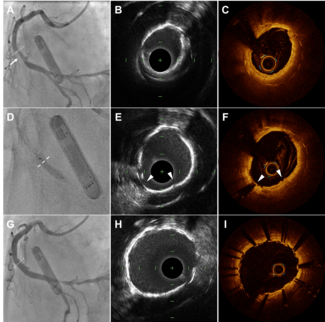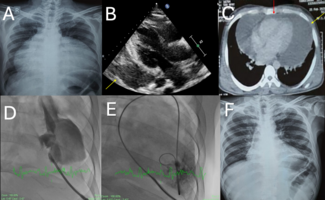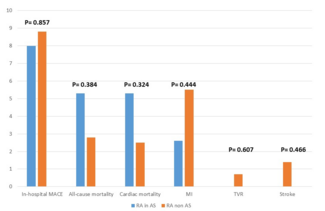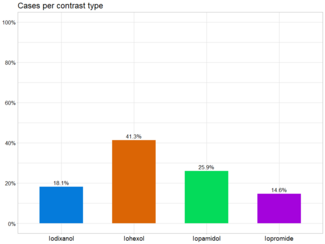Use of the RCB Guide in PCI of a Chronic Total Occlusion in an Anomalous Right Coronary Artery with High Anterior Takeoff
From the Department of Cardiology, Faculty of Medicine, Cumhuriyet University, Sivas, Turkey. The authors report no conflicts of interest regarding the content herein. Manuscript submitted December 3, 2008 and accepted February 13, 2009. Address for correspondence: Okan Turgut, MD, Department of Cardiology, Faculty of Medicine, Cumhuriyet University, Sivas 58140, Turkey. E-mail: okanturgut@lycos.com
_________________________________________________ ABSTRACT: An anomalous right coronary artery (RCA) with a high anterior takeoff is an uncommon and technically challenging vessel to cannulate and to intervene upon. We describe here an unusual case of chronic total occlusion in a patient with an anomalous dominant RCA accompanied by a high anterior takeoff, in whom there was insufficient catheter seating despite the exchange of several different guiding catheters during percutaneous intervention. This illustrative case demonstrates that if routine guiding catheters fail, early consideration can be made to use a right coronary bypass guiding catheter positioned with clockwise torque to obtain a stable platform for intervening on complex lesions in an anomalous RCA with a high anterior takeoff. This technique resulted in a successful procedure when many other guiding catheters had failed; it provided satisfactory back-up support for the passage of stent and balloon catheters and reduced the procedural time and radiation exposure, as well as the amount of radiocontrast agent used.
_________________________________________________
J INVASIVE CARDIOL 2009;21:e70–e72 The anomalous origin of the coronary arteries from the aorta is rare. An anomalous right coronary artery (RCA) with a high anterior takeoff is a particularly uncommon and technically challenging vessel to cannulate1,2 and to intervene upon. The high anterior location of the anomalous ostium is often difficult to access with routine catheters, and because of the abrupt posterior direction of the vessel, percutaneous intervention requires more secure guiding catheter support compared to a normally situated RCA. Although the anatomical and pathophysiological aspects of this coronary anomaly are well known, there is a paucity of relevant data on the management of this pathology in the setting of percutaneous coronary intervention (PCI). We describe here an unusual case of chronic total occlusion (CTO) in a patient with an anomalous dominant RCA accompanied by a high anterior takeoff, in which there was insufficient catheter seating despite the exchange of several different guiding catheters during percutaneous intervention. Case Report. A 68-year-old female with a known history of inferior myocardial infarction 6 months previously presented with lasting and severely disabling intractable angina refractory to maximal drug treatment. Her myocardial biomarker levels were normal and she had no new electrocardiographic changes, which would be otherwise indicative of acute coronary syndromes. On diagnostic angiography, there was great difficulty in cannulating the ostium of the RCA due to the superior and anterior takeoff of the vessel. Despite the use of various diagnostic catheters, an adequate angiographic view of the RCA was eventually acquired using a 6 Fr Multipurpose diagnostic catheter (Medtronic, Inc. Minneapolis, Minnesota), which showed a CTO involving the mid-segment of the vessel (Figure 1). No critical stenosis was present in the left coronary artery. There were no left-to-right collateral vessels. PCI of the anomalous RCA was therefore recommended. Coronary angioplasty was thus attempted, without success, using only 8 Fr Judkins right 4, Judkins left 3.5, Amplatz right 2, Amplatz left 1, right coronary bypass (RCB), and left coronary bypass guiding catheters (Medtronic), which were available at the time in our laboratory. Of all the catheters used, the tip of the RCB guiding catheter came closest to the ostium of the RCA and was tried again. With vigorous clockwise rotation, the tip of the catheter partially engaged the ostium of the RCA. Although the guiding catheter was not coaxial with the vessel, it allowed advancement of a 0.014 inch Asahi™ standard guidewire (Asahi Intecc, Aichi, Japan), which provided optimum stiffness and smooth transition of support with greater push and torque response into the vessel and beyond the CTO. The lesion was also crossed with difficulty, but ultimately with success, using a 2.0 x 25 mm Tamarin Blue® monorail balloon catheter (Natec Medical, Rose Hill, Mauritius), and was predilated at 10 atm (Figure 2). It was noticed that the ostium of the acute marginal branch was compromised. A 0.014 inch Asahi floppy guidewire was passed through the acute marginal branch and then the previous balloon catheter was reinserted through this second guidewire and inflated at the ostium of the acute marginal branch at 6 atm, restoring perfusion in this branch (Figures 3A and B). Finally, a 2.5 x 28 mm Yukon® stent (Translumina, Hechingen, Germany) was delivered to the mid-RCA and deployed at 14 atm, resulting in optimal angiographic patency of the stented site with good antegrade flow (Figure 4). At 3-month clinical follow up, the patient remains angina-free. Discussion. The anomalous origin of an RCA is an infrequent and potentially challenging vessel for PCI, especially when accompanied by a high anterior takeoff.3 Selecting the appropriate guiding catheter and careful manipulation are the most essential factors in achieving procedural success. The technical inconvenience of these aberrant vessels is reflected by the long procedural and fluoroscopy times, with most of the procedural time spent finding a suitable guiding catheter. There are no published series of PCI on anomalous RCAs, but review of the literature identified several case reports that have described successful balloon angioplasty of anomalous RCAs using mainly Amplatz guiding catheters.4–6 Likewise, stenting of an anomalous RCA has been successfully performed using an 8 Fr Amplatz Left 1 guiding catheter.7 Successful angioplasty and stenting of an anomalous RCA have also been described using a 6 Fr Judkins left 5 guiding catheter after failure with Amplatz Left 1 and multipurpose guiding catheters.8 A dedicated guiding catheter modification has recently been proposed for anomalous RCAs.9 As described by others,3,8 and as we experienced in our case, the various Amplatz catheter sizes may either be too short or too long. If too short, the tip may not reach the ostium; if too long, the catheter may prolapse into the left ventricle. Although the authors have attributed the success of the oversized 6 Fr Judkins Left guiding catheter to the flexibility of 6 Fr catheters, they have stated that it has supplied moderate backup support, which may be sufficient only for treating straightforward proximal RCA lesions.8 However, since the lesion in our patient was a CTO, we preferred a more consistent 8 Fr RCB guiding catheter, and were able to achieve a good outcome. Based on the case review and our experience, we recommend a stepwise approach to cannulate anomalous RCAs, starting with Judkins and Amplatz guiding catheters, possibly followed by a multipurpose guiding catheter (especially if the diagnostic catheter offers good cannulation and is available in the laboratory), and finally, if needed, an RCB guiding catheter. Whereas the overall prevalence of anomalous coronary arteries is relatively low, in this era of extensive use of PCI for the treatment of coronary artery disease, invasive cardiologists will likely encounter unusual cases such as the one reported here. No reliable estimate of the likelihood of success with angioplasty and stenting of such anomalous arteries is available (failures are unlikely to be reported), however, because these cases are rare, the reported experiences of other practitioners may provide helpful tips.10,11 This illustrative case highlights that if routine guiding catheters fail, the interventionist should consider using the RCB guiding catheter positioned with clockwise torque to obtain a stable platform for intervening upon complex lesions of an anomalous RCA with a high anterior takeoff. This technique resulted in a successful procedure when many other guiding catheters failed, provided satisfactory backup support for passage of stent and balloon catheters, and reduced procedural time and radiation exposure, as well as the amount of radiocontrast agent used.
2. Tarhan A, Kehlibar T, Yilmaz M, et al. Right coronary artery with high takeoff. Ann Thorac Surg 2007;83:1867–1869.
3. Lee BI, Gist HC Jr, Morris EI. Percutaneous coronary artery stenting of an anomalous right coronary artery with high anterior takeoff using standard size 7 French left Judkins guiding catheters. J Invasive Cardiol 2003;15:682–684.
4. Musial B, Schob A, De Marchena E, Kessler KM. Percutaneous transluminal coronary angioplasty of anomalous right coronary artery. Cathet Cardiovasc Diagn 1991;22:39–41.
5. Charney R, Spindola-Franco H, Grose R. Coronary angioplasty of anomalous right coronary arteries. Cathet Cardiovasc Diagn 1993;29:233–235.
6. Yeoh JK, Ling LH, Maurice C. Percutaneous transluminal angioplasty of anomalous right coronary artery arising from the ascending thoracic aorta. Cathet Cardiovasc Diagn 1994;32:254–256.
7. Olympios CD, Sifaki MD, Lembidakis EG, et al. Coronary stenting of an anomalous right coronary artery. J Invasive Cardiol 1998;10:342–345.
8. Ng W, Chow WH. Successful angioplasty and stenting of anomalous right coronary artery using a 6 French left Judkins #5 guide catheter. J Invasive Cardiol 2000;12:373–375.
9. Rossen JD. Technical note: A useful guide catheter modification for anomalous right coronary arteries. Catheter Cardiovasc Interv 2005;65:37–40.
10. Kaneda H, Takahashi S, Saito S. Successful coronary intervention for chronic total occlusion on an anomalous right coronary artery using the retrograde approach via a collateral vessel. J Invasive Cardiol 2007;19:1–4.
11. Graidis C, Dimitriadis D, Chamouratidis N. Percutaneous coronary intervention of a totally occluded anomalous right coronary artery arising from the left sinus of Valsalva with the use of multiple overlapping drug-eluting stents (“full-metal jacket” technique). J Invasive Cardiol 2007;19:E261–E262.


















